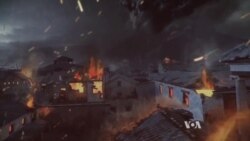LOS ANGELES —
One of the worst natural disasters in recorded history, the destruction of Pompeii by a volcano nearly 2,000 years ago, has often been the subject of Hollywood drama. Now the California Science Center is presenting the history, and the science, behind the tragedy.
Mt. Vesuvius unleashed fiery gases and scorching ash on August 24th in 79 A.D. Visitors to the California Science Center watch a computer-generated film reconstructing the tragedy.
The disaster has been shown on screen many times, in a short 1907 French documentary, an Italian feature from 1913, and in later Hollywood treatments, including this year's epic Pompeii.
Archeologist Kenneth Lapatin says hot ash preserved the outlines of the victims, and kept intact many everyday items that surrounded them.
“When we go to Rome, we have the glorious shells of great imperial buildings. What Pompeii gives us is something we do not get in the literary sources, which is the everyday, the domestic, the simple," said Lapatin.
Including the coins and artwork, household gods, work tools and cooking utensils.
Pompeii was a small commercial city away from the ancient Roman centers of power, and its neighboring community Herculaneum was a Mediterranean resort. Both were buried in the eruption. Diane Perlov of the California Science Center says they still hold a fascination.
“It was luxurious, it was high living, and then it was just wiped off the face of the earth all at once. There is something very mythical about that story," said Perlov.
Lapatin says the film Pompeii, released in February, brought that drama to the screen with a mix of fact and fiction.
“The latest Pompeii film, I think, did a really good job of capturing urban topography. They did flights over the site and they computer-reconstructed the city. The volcano, I think they did a good job of. They did not have a lot of lava. They had volcanic gasses and clouds and mudslides," he said.
That science is explained at the Center's exhibit, along with a fascinating glimpse into the everyday lives of these ancient Romans; their medical tools, art works, and the weapons and armor used by gladiators. About 150 items are on loan from the Naples National Archeological Museum.
California Science Center president Jeff Rudolph says there is a message in the exhibit.
“The forces of nature are incredibly strong and we have learned to live with them, but they can have catastrophic consequences," said Rudolph.
Pompeii was rediscovered in the 18th century buried beneath the ash, with haunting images that stare out from its art work. Kenneth Lapatin says that faces from the past speak to modern viewers.
“We see ourselves in the past, and that is why for 250 years, Pompeii since its rediscovery has been incredibly popular and exhibitions like this one are so exciting," he said.
And why the drama of Pompeii still intrigues us.
Mt. Vesuvius unleashed fiery gases and scorching ash on August 24th in 79 A.D. Visitors to the California Science Center watch a computer-generated film reconstructing the tragedy.
The disaster has been shown on screen many times, in a short 1907 French documentary, an Italian feature from 1913, and in later Hollywood treatments, including this year's epic Pompeii.
Archeologist Kenneth Lapatin says hot ash preserved the outlines of the victims, and kept intact many everyday items that surrounded them.
“When we go to Rome, we have the glorious shells of great imperial buildings. What Pompeii gives us is something we do not get in the literary sources, which is the everyday, the domestic, the simple," said Lapatin.
Including the coins and artwork, household gods, work tools and cooking utensils.
Pompeii was a small commercial city away from the ancient Roman centers of power, and its neighboring community Herculaneum was a Mediterranean resort. Both were buried in the eruption. Diane Perlov of the California Science Center says they still hold a fascination.
“It was luxurious, it was high living, and then it was just wiped off the face of the earth all at once. There is something very mythical about that story," said Perlov.
Lapatin says the film Pompeii, released in February, brought that drama to the screen with a mix of fact and fiction.
“The latest Pompeii film, I think, did a really good job of capturing urban topography. They did flights over the site and they computer-reconstructed the city. The volcano, I think they did a good job of. They did not have a lot of lava. They had volcanic gasses and clouds and mudslides," he said.
That science is explained at the Center's exhibit, along with a fascinating glimpse into the everyday lives of these ancient Romans; their medical tools, art works, and the weapons and armor used by gladiators. About 150 items are on loan from the Naples National Archeological Museum.
California Science Center president Jeff Rudolph says there is a message in the exhibit.
“The forces of nature are incredibly strong and we have learned to live with them, but they can have catastrophic consequences," said Rudolph.
Pompeii was rediscovered in the 18th century buried beneath the ash, with haunting images that stare out from its art work. Kenneth Lapatin says that faces from the past speak to modern viewers.
“We see ourselves in the past, and that is why for 250 years, Pompeii since its rediscovery has been incredibly popular and exhibitions like this one are so exciting," he said.
And why the drama of Pompeii still intrigues us.






